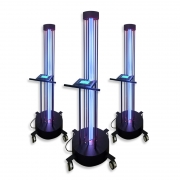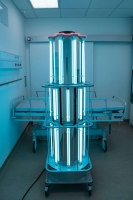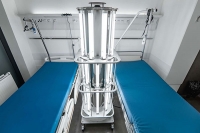Disinfection Robots can Halt The Spread Of Infectious Disease In hospitals.
Robots that can disinfect hospitals could be extremely effective in fighting infections in healthcare settings and could slow the spread of the coronavirus.
The BBC report that demand has soared for the automated devices which have been developed to kill viruses, bacteria and other harmful microbes.
The autonomous Disinfectant robots are fitted with powerful UV-C ultraviolet lights which damage the DNA and RNA of infectious microorganisms so that they can’t multiply. The use of UV-C light to kill bugs is not a particularly new technology but until recent advances in robotics, using it to disinfect complex layouts covering many square feet has been difficult to achieve.
Preventing the spread of diseases, particularly given the coronavirus crisis, is an essential, and unending task for hospitals and other medical facilities. Cleaning and disinfecting surfaces, floors, walls and everything else is a dirty, repetitive and potentially dangerous task for staff. That makes it an ideal process for an automated, robotic device.
The use of UV-C light to kill infection
UV light can be dangerous to humans. To be effective it must be focused on a surface for a couple of minutes. Manually operating UV-C systems in large environments like a hospital is difficult and time-consuming. Humans can miss areas harbouring viruses and bacteria or not expose surfaces for long enough and render disinfection techniques as ineffective.
Disinfectant robots have been widely adopted in the USA in recent years. Their uptake has dramatically increased in tech-savvy China, a country which has truly embraced robotics and automation, as well as in countries such as Italy and Thailand which have been badly affected by the recent pandemic.
How UVC disinfecting robots work
The robots are controlled by computer and navigate using multiple sensor modules. The robot is deployed to scan each room and identify the areas which require disinfecting. The devices can be fitted with movement sensors to shut off the UV-C lights should a human enter an area during the process.
The robot is more consistent than a staff member as it follows the same path each and every time to ensure everything that requires disinfecting is targeted. As with all automated robotic tasks, that frees up human resources to carry out more satisfying, complex and less dangerous tasks.
Even before the coronavirus outbreak, patients acquiring infections in hospitals has been a global and ongoing problem. In the UK, the National Institute for Health and Care Excellence (NICE) estimate that 300,000 people in England pick up an infection in an NHS setting every year. That equates to over 6 percent of every person who attends a healthcare facility.
The coronavirus has only accelerated the need for an effective solution to what amounts to a huge, costly and potentially deadly problem. Global crises such as a pandemic on the scale seen recently, rarely produce many positive outcomes but the rapid advances in disinfecting robots may be one gain for the future out of the terrible situation which has faced the world.




